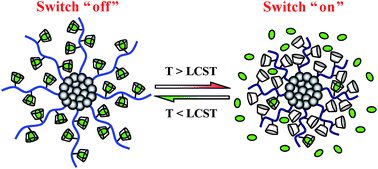Temperature-switched controlled release nanosystems based on molecular recognition and polymer phase transition†
Abstract
Environmental stimuli-responsive nanosystems that can release their encapsulated or loaded substances in spatial-, temporal- and dosage-controlled fashions have attracted tremendous attention, especially from the field of nanomedicine. In this work, a novel temperature-switched controlled release nanosystem based on the molecular recognition of beta-cyclodextrin (β-CD) and thermosensitivity based on the phase transition of poly(N-isopropylacrylamide) (PNIPAM) is developed. This smart nanosystem consists of magnetic Fe3O4 colloidal nanocrystal clusters (MCNCs) core grafted with linear PNIPAM chains attached to numerous β-CD units, (denoted as Fe3O4@PNG–CD). β-CD units act as containers for the loading of hydrophobic model drugs, PNIPAM chains serve as intelligent “microvalves” for controlling the release of loaded model drugs, and MCNCs core can achieve a “site-specific targeting” function. The gating mechanism involves that temperature can significantly affect the association constants of β-CD toward model drug molecules in β-CD modified PNIPAM chains. The resultant Fe3O4@PNG–CD nanoparticles have excellent thermo-reversible adsorption/desorption properties for the loaded model drug 8-anilino-1-naphthalenesulfonic acid ammonium salt (ANS), and demonstrate a positive temperature “on–off” release fashion. By simply changing the temperature, the delivery rate can be effectively controlled. At temperature above the lower critical solution temperature (LCST) of the grafted PNG–CD chains (open gate), the delivery rate of ANS is fast, but very slow at temperature below the LCST (closed gate). These multifunctional nanoparticles provide a new mode for designing and engineering intelligent controlled release nanosystems.


 Please wait while we load your content...
Please wait while we load your content...